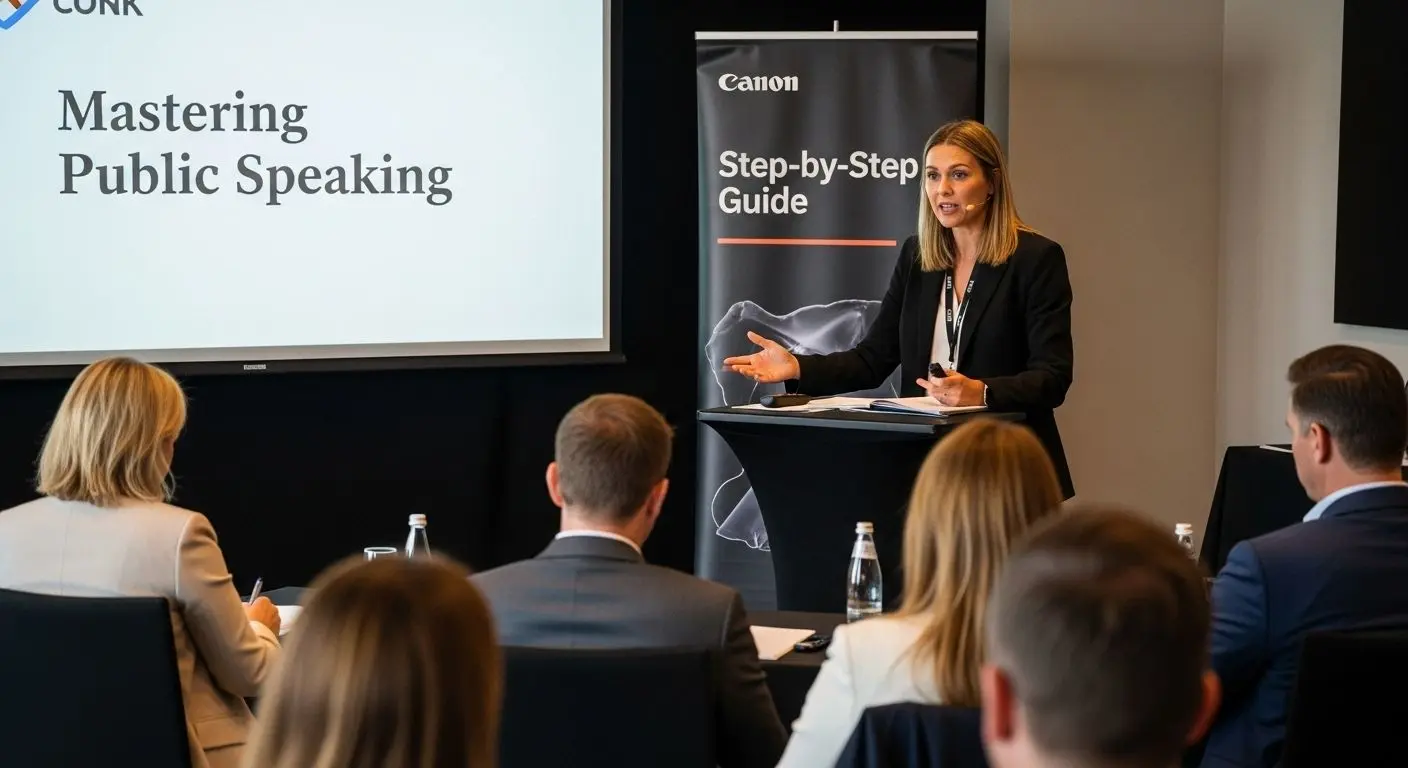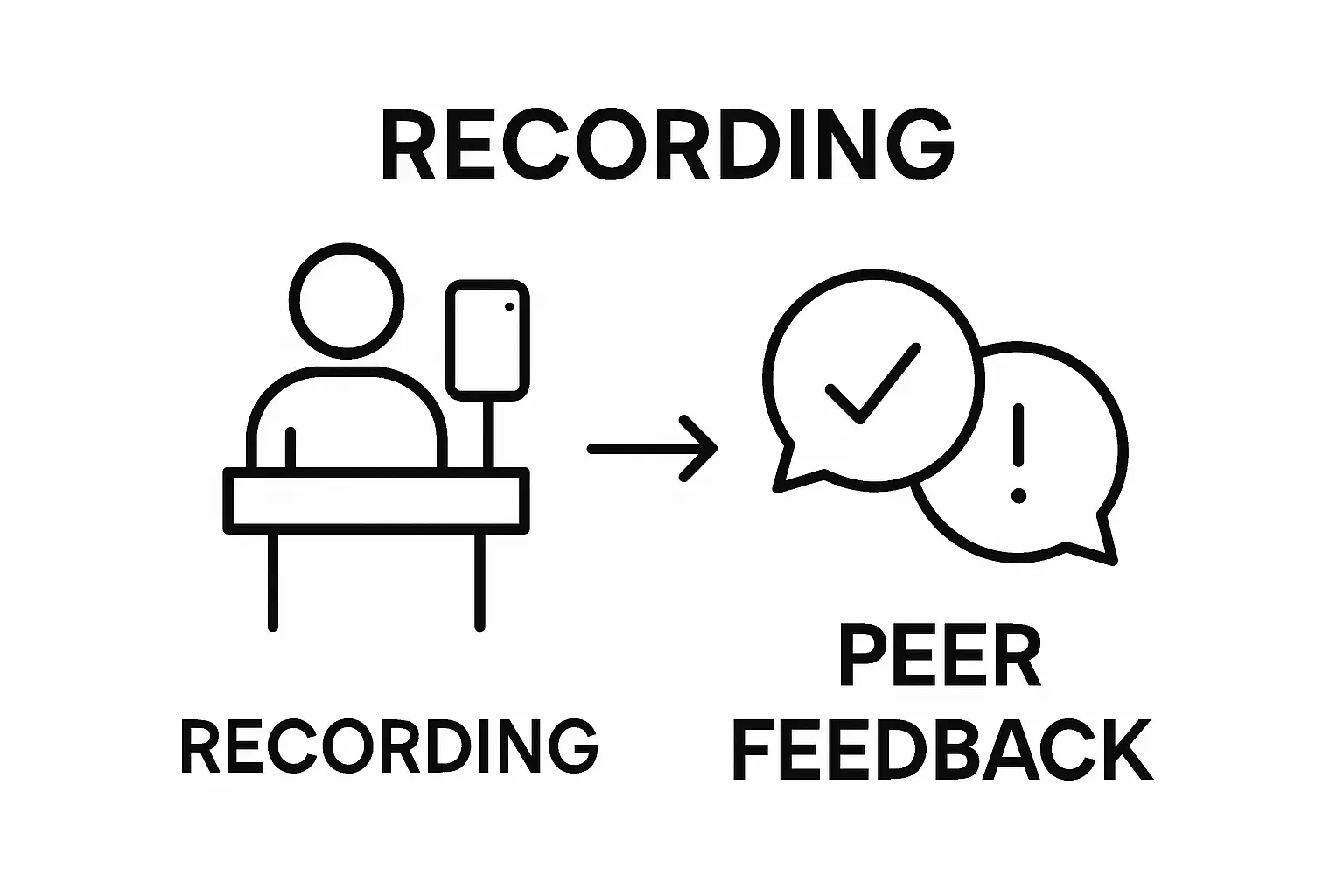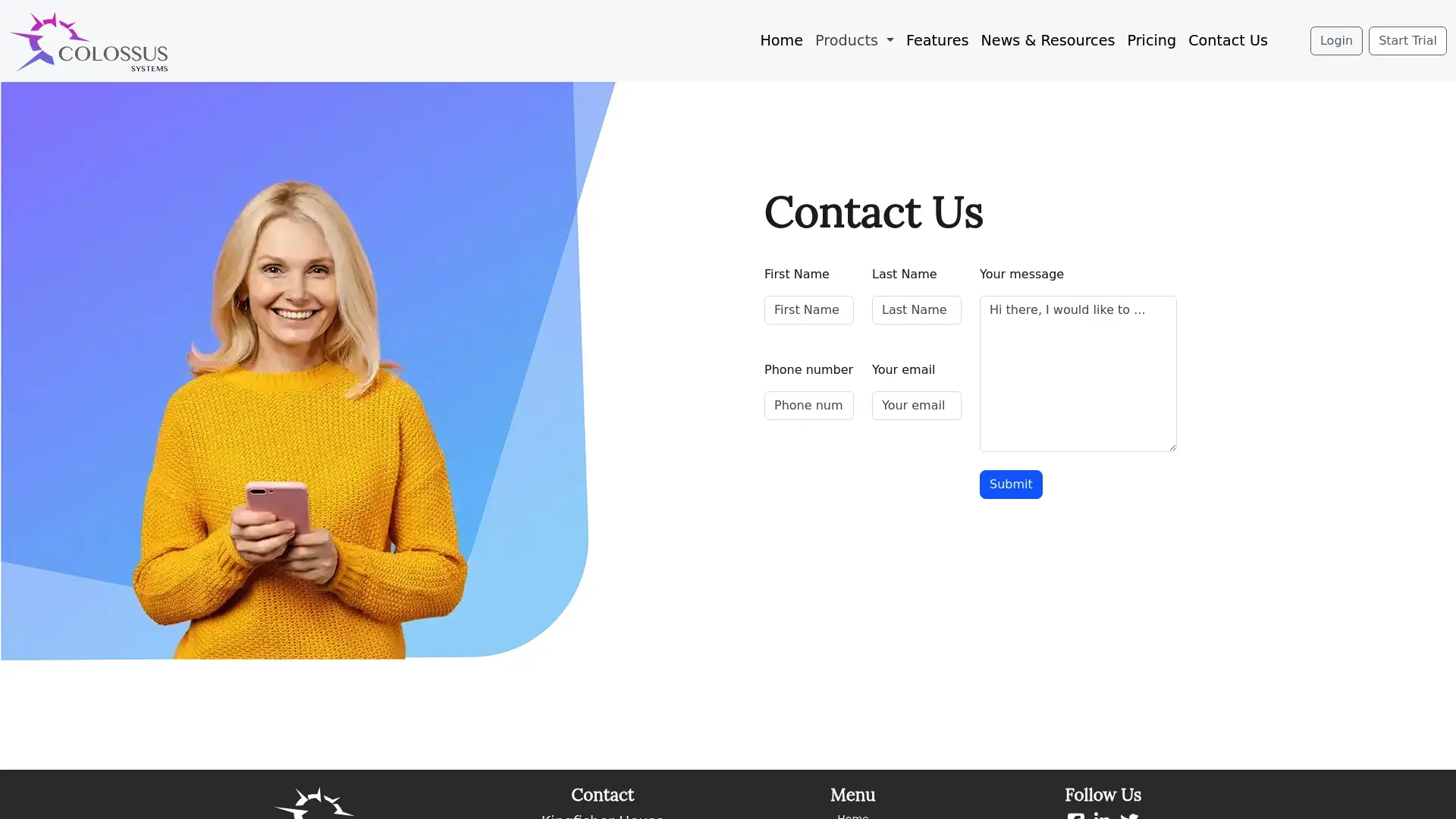Mastering Public Speaking for Leaders: A Step-by-Step Guide

Polished public speaking turns average leaders into unforgettable ones. Most professionals overlook that 72 percent of people rate public speaking as their top fear, even higher than death. Strangely, those who embrace uncomfortable feedback and honest self-reflection often achieve remarkable breakthroughs in their presentation skills.
Table of Contents
- Step 1: Assist Your Current Speaking Skills
- Step 2: Define Your Audience’s Expectations
- Step 3: Craft A Compelling Message
- Step 4: Develop Engaging Visual Aims
- Step 5: Practice Your Delivery Techniques
- Step 6: Seek Feedback And Refine Your Performance
Quick Summary
| Key Point | Explanation |
|---|---|
| 1. Self-assess your speaking skills | Record your speeches to objectively evaluate your body language, tone, and confidence level for improvement. |
| 2. Understand your audience’s expectations | Research audience demographics and interests to tailor your message effectively, ensuring relevance and engagement. |
| 3. Craft a clear and compelling message | Develop a central thesis that resonates emotionally and logically with your audience, inspiring action through storytelling. |
| 4. Implement effective visual aids | Use clear, professional visuals that enhance understanding without distracting, ensuring they align with your core message. |
| 5. Seek feedback and refine your performance | Collect specific, actionable feedback from diverse sources to identify areas for improvement and foster continuous growth. |
Step 1: Assist Your Current Speaking Skills
Mastering public communication begins with honest self-evaluation. Before developing advanced techniques, leaders must understand their current communication baseline and identify specific areas requiring improvement. This foundational step creates a personalized roadmap for professional growth in public presentation skills.
Self-Assessment Techniques
Start by recording yourself delivering a presentation or speech. Use your smartphone or computer to capture video, which provides an objective perspective impossible to achieve through memory alone. Watch the recording carefully, paying attention to body language, vocal tone, clarity of speech, and overall confidence level. Most professionals find this initial viewing uncomfortable but incredibly revealing.
During your review, focus on specific performance indicators. How often do you use filler words like “um” or “ah”? Do you maintain consistent eye contact? Are your gestures natural and supportive of your message? Notice patterns in your communication that might distract from your core content.
Seeking External Feedback
Complement self-assessment by requesting honest feedback from trusted colleagues or mentors. According to research from Amherst College, professional peer evaluation provides critical insights into communication effectiveness. Choose individuals who will offer constructive criticism rather than simple praise.
Invite them to observe a presentation and provide specific feedback. Request they evaluate your:
- Clarity of message
- Presentation structure
- Audience engagement
- Nonverbal communication
- Overall confidence
Document their observations systematically. Look for consistent themes or repeated comments, as these likely represent genuine areas for development. Remember that feedback is a gift, not a personal critique.

Successful completion of this assessment step means having a clear, honest understanding of your current public communication strengths and opportunities for growth. This foundational knowledge will directly inform your strategy in subsequent skill development stages.
Step 2: Define Your Audience’s Expectations
Understanding your audience represents a critical bridge between effective communication and potential disconnection. Public speakers who master audience analysis transform presentations from monologues into meaningful dialogues, creating powerful connections that resonate beyond initial impressions.
Audience Demographic Research
Begin your audience analysis by gathering comprehensive information about who will be listening. Professional contexts demand nuanced understanding beyond basic demographics. Consider professional backgrounds, potential knowledge levels, generational perspectives, and potential motivations for attending your presentation. Are they peers, subordinates, industry professionals, or potential investors? Each group requires a tailored communication approach.
Conduct preliminary research through event organisers, meeting coordinators, or direct communication with potential attendees. Request information about professional roles, experience levels, and potential interests related to your presentation topic. Some organisations might provide attendee profiles or registration data that offer valuable insights.
Expectation Mapping
Once you understand your audience’s composition, map their potential expectations. This involves anticipating their primary questions, underlying concerns, and desired outcomes. According to research from the University of Pittsburgh, effective audience analysis extends beyond surface-level demographics to understanding psychological and professional contexts.
Prepare a preliminary outline that addresses potential audience perspectives. Consider what technical depth they might expect, what professional challenges they might be experiencing, and what solutions or insights they hope to gain. Your presentation should feel like a precisely calibrated response to their unspoken professional needs.
Successful audience expectation definition means you can confidently predict and address potential questions, demonstrate understanding of their professional context, and design a presentation that feels personally relevant to each listener. Learn more about crafting engaging presentations that connect authentically with diverse audiences.
Verify your audience analysis by creating a brief checklist:
Here is a checklist table to help verify your audience analysis before preparing your presentation, ensuring alignment with audience expectations and information needs.
| Verification Criterion | Description |
|---|---|
| Professional background alignment | Confirm your content relates to the audience’s professional roles and sectors. |
| Knowledge level assessment | Evaluate the expected knowledge and expertise of attendees. |
| Potential information needs | Identify key topics and areas the audience seeks to address. |
| Expected presentation depth | Assess the appropriate technical or conceptual depth for your material. |
| Anticipated audience questions | Anticipate likely queries and concerns based on research and context. |
- Professional background alignment
- Knowledge level assessment
- Potential information needs
- Expected presentation depth
- Anticipated audience questions
This strategic approach transforms public communication from a generic delivery into a precision-engineered professional interaction.

Step 3: Craft a Compelling Message
Crafting a compelling message transforms ordinary communication into an extraordinary leadership moment. Your message represents more than words spoken aloud it is a strategic instrument designed to influence, inspire, and invoke meaningful action among your listeners.
Message Architecture
Begin by establishing a clear central thesis that serves as the gravitational core of your presentation. Powerful messages have three fundamental characteristics: they are concise, emotionally resonant, and directly aligned with your audience’s core interests. Imagine your message as a precision instrument engineered to connect with your listeners intellectual and emotional landscapes.
Structure your narrative around a compelling arc that builds tension, provides insight, and offers resolution. Start with a provocative opening that immediately captures attention. This could be a startling statistic, a thought provoking question, or a personal anecdote that illustrates your core message. According to Toastmasters International, the first 30 seconds are crucial in determining audience engagement.
Emotional and Logical Resonance
Balance emotional storytelling with logical evidence. Humans make decisions through a combination of feelings and rational thought. Your message should weave personal stories that humanize your content with concrete data that substantiates your perspective. Use metaphors that translate complex ideas into relatable concepts. Practice translating technical information into language that feels accessible and meaningful.
Evaluate your message through a rigorous internal review process. Potential verification criteria include:
- Clarity of central argument
- Emotional engagement potential
- Logical coherence
- Relevance to audience expectations
- Potential for inspiring action
Consider developing robust communication strategies that can help refine your messaging approach. Your final message should feel like a precisely calibrated communication instrument designed to transform listener perspectives and inspire meaningful change.
Successful message crafting means creating a narrative so compelling that your audience feels personally invested in your words, seeing themselves within the story you are telling.
Step 4: Develop Engaging Visual Aims
Visual communication represents a powerful amplification of your spoken message, transforming abstract concepts into tangible, memorable experiences. Well-crafted visual assets do more than decorate your presentation they serve as strategic communication tools that enhance understanding and retention.
Visual Strategy Development
Begin by selecting visual formats that complement your message rather than distract from it. Professional visual design demands intentionality. Each graphic, chart, or image should serve a specific communicative purpose. Avoid cluttered slides or overly complex infographics that overwhelm your audience. Instead, focus on clean, minimalist designs that highlight key information with precision.
Choose visual styles that match your professional context and audience expectations. Technical presentations might require data visualizations, while leadership talks could benefit from metaphorical imagery that illustrates complex concepts. Consider colour psychology color selection influences emotional response and perception. Blues communicate professionalism, greens suggest growth, and warm tones can create energy and engagement.
Technical Execution
Technical quality matters as much as conceptual design. According to research from the University of Pittsburgh, visual clarity directly impacts audience comprehension. Use high resolution images, consistent typography, and professional design tools like Microsoft PowerPoint, Apple Keynote, or specialist design platforms like Canva. Test your visuals on different screen sizes to ensure readability and impact.
Explore advanced presentation techniques to elevate your visual communication skills. Your goal is creating visual narratives that feel intuitive and seamless.
Verify your visual aid effectiveness through these critical assessment criteria:
- Clarity of information presentation
- Alignment with core message
- Visual aesthetic consistency
- Technical image quality
- Audience comprehension potential
Successful visual aid development transforms your presentation from a mere information delivery into an immersive, memorable communication experience. Each visual should feel like a deliberate, strategic choice that amplifies your leadership voice.
Step 5: Practice Your Delivery Techniques
Delivery techniques transform carefully crafted content into a powerful communication experience. Your presentation exists not just as words but as a dynamic performance that requires intentional practice, strategic refinement, and confident execution.
Systematic Practice Approach
Begin by creating a structured practice environment that mimics real presentation conditions. Authentic rehearsal demands more than simple memorization. Set up a dedicated space with minimal distruptions where you can record yourself delivering the presentation. Use your smartphone or computer to capture video, allowing you to observe your performance objectively. Professional speakers understand that watching themselves provides unparalleled insights into body language, vocal patterns, and overall presentation dynamics.
Focus on specific delivery elements during each practice session. Concentrate on vocal variety first vocal monotony can quickly disengage an audience. Practice modulating your tone, adjusting volume, and introducing strategic pauses that create emphasis and allow listeners to absorb complex information. According to research from MIT, intentional practice focusing on specific skills yields significantly better results than generic rehearsal.
Performance Refinement
Develop a feedback loop that continuously improves your delivery. Invite trusted colleagues to watch your practice sessions and provide constructive criticism. Professional feedback helps identify blind spots in your communication style that you might not recognize independently. Pay special attention to your non verbal communication gestures, eye contact, and overall stage presence communicate as powerfully as your spoken words.
Explore advanced presentation techniques to further enhance your public communication skills. Developing muscle memory through consistent, purposeful practice transforms nervousness into confident performance.
Verify your delivery technique mastery through these critical assessment criteria:
The following table provides an overview of critical delivery technique assessment criteria to evaluate and refine your public speaking performance.
| Assessment Criterion | What to Check |
|---|---|
| Vocal variety and modulation | Assess diversity in tone, pace, and volume to maintain interest. |
| Natural body language | Observe gestures, stance, and facial expressions for authenticity. |
| Audience engagement potential | Gauge the degree to which your delivery keeps the audience attentive. |
| Confidence level | Look for signs of self-assurance and calmness in your performance. |
| Clarity of message delivery | Ensure your key points are communicated clearly and concisely. |
- Vocal variety and modulation
- Natural body language
- Audience engagement potential
- Confidence level
- Clarity of message delivery
Successful delivery technique practice means transforming your presentation from a script to a living, breathing communication experience that feels authentic and compelling.
Step 6: Seek Feedback and Refine Your Performance
Feedback represents the crucible where raw communication skills are transformed into polished leadership capabilities. Seeking constructive criticism requires courage, humility, and a strategic approach to professional development that separates exceptional communicators from ordinary speakers.
Feedback Collection Strategy
Professional feedback demands a systematic approach. Begin by creating a diverse feedback panel comprising individuals from different professional backgrounds. Seek perspectives from peers, mentors, senior leaders, and even audience members who can provide nuanced insights into your presentation style. The goal is not to collect generic compliments but to gather specific, actionable observations that illuminate potential areas of improvement.
Design a structured feedback mechanism that goes beyond surface level comments. Provide your reviewers with specific evaluation criteria that guide their observations. Request detailed commentary on aspects like message clarity, delivery confidence, body language, vocal variation, and audience engagement. Encourage honest, direct feedback by creating a safe environment where constructive criticism is viewed as a gift of professional development.
Performance Refinement Process
Transform feedback into deliberate performance improvements. According to research in leadership communication, systematic feedback with repeated practice leads to significant skill enhancement. Review each piece of feedback objectively, looking for consistent themes or recurring suggestions. Avoid becoming defensive create a growth mindset that views each critique as an opportunity to elevate your communication capabilities.
Discover advanced communication improvement techniques to further refine your leadership presentation skills. Professional growth requires continuous learning and adaptation.
Verify the effectiveness of your feedback collection through these critical assessment criteria:
- Diversity of feedback sources
- Specificity of collected insights
- Actionable improvement recommendations
- Personal emotional response to criticism
- Implementation of suggested refinements
Successful feedback integration means transforming external perspectives into a powerful personal development strategy that continuously elevates your public communication capabilities.
Elevate Your Leadership Communication With Colossus Systems
Struggling to keep your team engaged or to turn your polished public speaking into genuine, lasting connections within your organisation? In the journey to master public speaking, many leaders uncover deeper challenges such as lack of audience insight, limited feedback, and disjointed digital engagement for their communities. Customised message architecture, engaging delivery and actionable feedback, as detailed in the article, are only truly effective when you have the right support and tools.

Colossus Systems empowers membership organisations to bridge the gap between effective presentation and ongoing member interaction. Our SaaS platform gives you everything from event management tools for seamless presentation delivery, to integrated communication features that keep your message resonating with your audience well after the applause. Leverage our advanced analytics and engagement tools to measure the real impact of your public speaking. Ready to transform your next speech into a catalyst for organisational growth? Enquire now to see how Colossus Systems can support your leadership and member engagement strategy.
Frequently Asked Questions
What are the key steps to mastering public speaking for leaders?
To master public speaking, leaders should follow six key steps: assess current speaking skills, define audience expectations, craft a compelling message, develop engaging visual aids, practice delivery techniques, and seek feedback for refinement.
How can I effectively assess my current public speaking skills?
You can assess your skills by recording your presentations and reviewing them for body language, vocal tone, clarity, and confidence. Additionally, seek constructive feedback from colleagues to identify areas for improvement.
What should I consider when analysing my audience’s expectations?
When analysing your audience, consider their professional backgrounds, knowledge levels, and motivations for attending your presentation. Understanding their primary questions and desired outcomes will help in tailoring your message effectively.
How can I create a compelling message for my presentation?
To create a compelling message, establish a clear central thesis, structure your narrative with a gripping arc, and balance emotional storytelling with logical evidence. Ensure your message resonates with your audience’s interests and expectations.